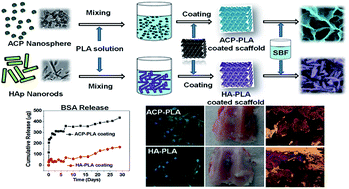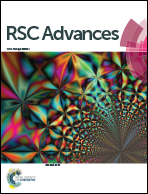The mineralization, drug release and in vivo bone defect repair properties of calcium phosphates/PLA modified tantalum scaffolds†
Abstract
Calcium phosphate based biomaterials have been widely studied in biomedical areas. Herein, amorphous calcium phosphate (ACP) nanospheres and hydroxyapatite (HA) nanorods were separately prepared and used for coating tantalum (Ta) scaffolds with a polymer of polylactide (PLA). We have found that different crystal phases of calcium phosphate coated on Ta scaffolds displayed different effects on the surface morphologies, mineralization and bovine serum albumin (BSA) release. The ACP-PLA and HA-PLA coated on Ta scaffold were more favorable for in vitro mineralization than bare and PLA coated Ta scaffolds, and resulted in a highly hydrophilic surfaces. Meanwhile, the osteoblast-like cells (MG63) showed favorable properties of adhesion and spreading on both ACP-PLA and HA-PLA coated Ta scaffolds. The ACP-PLA and HA-PLA coated Ta scaffolds showed a high biocompatibility and potential applications for in vivo bone defect repair.



 Please wait while we load your content...
Please wait while we load your content...